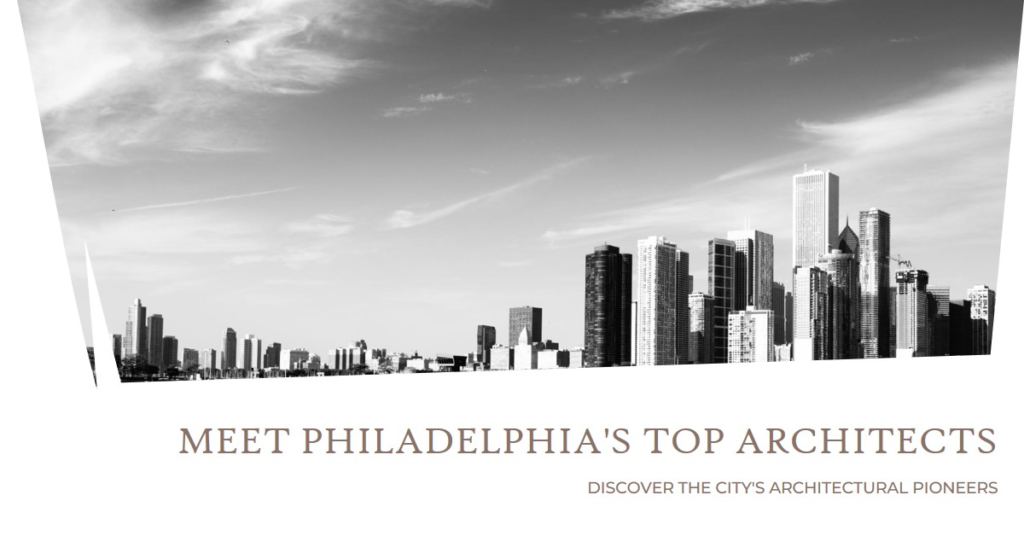
Table of Contents
Introduction:
In the heart of Philadelphia lies a treasure trove of architectural marvels, each a testament to the vision and skill of the city’s top architects. From historic landmarks to modern skyscrapers, Philadelphia’s skyline is a living canvas that reflects the ingenuity and creativity of its architectural pioneers. In this blog post, we embark on a journey to uncover the stories behind the iconic structures that define Philadelphia’s architectural landscape and the brilliant minds that brought them to life.
The Rich Tapestry of Philadelphia’s Architectural Heritage
Philadelphia’s architectural heritage is a tapestry woven with threads of history, innovation, and cultural diversity. From the cobblestone streets of Old City to the towering glass facades of Center City, every corner of the city tells a story of architectural evolution. The colonial-era buildings, such as Independence Hall and the Liberty Bell Center, stand as enduring symbols of Philadelphia’s role in shaping the nation’s history.
William Strickland: Pioneer of Neoclassical Architecture
Among Philadelphia’s architectural luminaries, William Strickland stands out as a pioneer of neoclassical design. His iconic structures, including the Second Bank of the United States and the Merchants’ Exchange Building, embody the elegance and grandeur of the neoclassical style. Strickland’s mastery of proportion, symmetry, and classical motifs left an indelible mark on Philadelphia’s architectural landscape, inspiring generations of architects to come.
Frank Furness: The Maverick of Victorian Architecture
In the Victorian era, Frank Furness defied convention with his bold and expressive architectural style. Known for his intricate detailing and eclectic mix of materials, Furness’s buildings, such as the Pennsylvania Academy of the Fine Arts and the Fisher Fine Arts Library, exude a sense of dynamism and vitality. Despite facing criticism during his lifetime, Furness’s legacy endures as a testament to his uncompromising vision and innovative spirit.
Louis Kahn: Master of Modernism
Louis Kahn’s timeless designs continue to captivate admirers around the world, and his impact on Philadelphia’s architectural scene is profound. With iconic works like the Richards Medical Research Laboratories and the Kimbell Art Museum, Kahn pushed the boundaries of modernism while staying true to the principles of space, light, and form. His minimalist approach and reverence for materials resonate deeply in Philadelphia’s urban fabric, leaving an indelible imprint on the cityscape.
Robert Venturi and Denise Scott Brown: Champions of Postmodernism
Robert Venturi and Denise Scott Brown brought a fresh perspective to Philadelphia’s architectural scene with their embrace of postmodernism. Their seminal work, “Learning from Las Vegas,” challenged the modernist orthodoxy and celebrated the vernacular architecture of everyday life. Buildings like the Guild House and the Sainsbury Wing of the National Gallery in London showcase Venturi and Scott Brown’s playful use of historical references and bold ornamentation, redefining the boundaries of architectural discourse.


Moshe Safdie: Innovator of Urban Habitats
Moshe Safdie’s visionary designs have reshaped the urban landscape, blending modernist principles with a humanistic approach to architecture. In Philadelphia, Safdie’s contributions include the National Museum of American Jewish History and the Penn’s Landing Redevelopment Plan, which prioritize connectivity and community engagement. Safdie’s emphasis on sustainable design and social responsibility reflects Philadelphia’s commitment to building a more inclusive and resilient city for future generations.
Tod Williams and Billie Tsien: Guardians of Craftsmanship
Tod Williams and Billie Tsien’s architecture is defined by its timeless elegance and meticulous attention to detail. Their projects, such as the Barnes Foundation and the Logan Center for the Arts, celebrate the art of craftsmanship and the power of spatial experience. Williams and Tsien’s commitment to materiality and craftsmanship resonates deeply in Philadelphia’s architectural heritage, enriching the cityscape with enduring works of beauty and meaning.
Cecil Baker: Steward of Urban Revitalization
Cecil Baker’s architectural practice is synonymous with urban revitalization and adaptive reuse. Through projects like the Philadelphia Navy Yard Master Plan and the Divine Lorraine Hotel restoration, Baker has breathed new life into neglected spaces, transforming them into vibrant hubs of activity and innovation. Baker’s holistic approach to design emphasizes sustainability, community engagement, and historic preservation, reflecting Philadelphia’s ongoing evolution as a dynamic and resilient city.
The Future of Philadelphia Architecture: Embracing Innovation and Sustainability
As Philadelphia continues to grow and evolve, the future of its architecture lies in embracing innovation, sustainability, and social equity. Architects like KieranTimberlake and DIGSAU are leading the way with projects that prioritize environmental stewardship, technological advancement, and community-centered design. From green infrastructure initiatives to adaptive reuse strategies, Philadelphia’s architectural pioneers are shaping a more resilient and inclusive city for generations to come.
Conclusion:
Philadelphia’s architectural pioneers have left an indelible mark on the city’s skyline, shaping its identity and inspiring future generations of designers and dreamers. From neoclassical grandeur to postmodern whimsy, each architect brings a unique perspective to Philadelphia’s rich tapestry of architectural innovation. As the city continues to evolve, the legacy of these master builders will endure, guiding the way toward a more vibrant, sustainable, and equitable future for all who call Philadelphia home.


